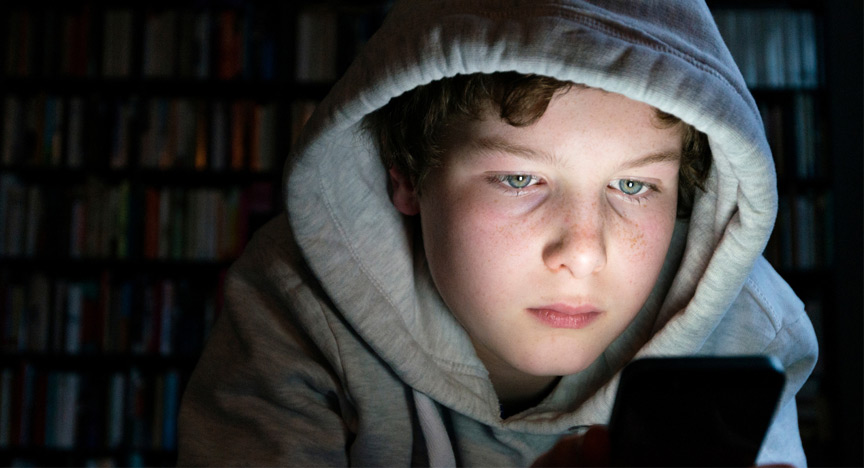
Thanks to our growing reliance on the internet and social media, cyberbullying is becoming one of the most prominent ways to attack someone. It’s effective, destructive, and most worryingly, easy to pull off.
One of the most damaging aspects of cyberbullying is that it’s difficult to get away from. It extends beyond the schoolyard and into the home and does not stop when the day is over. Your child could be receiving harmful messages or be the focus of hurtful memes and videos 24/7.
Cyberbullies are often motivated to target people online because it can be difficult to monitor. It can be challenging for parents and caregivers to protect their kids from cyberbullying, as it can occur across multiple social media platforms and accounts. Your child might be a target of cyberbullying without you ever realising it.
It’s vital for parents and caregivers to be aware of the signs and seek help immediately. Most importantly, it’s important for children to know there is help available.
What is cyberbullying?
Cyberbullying (including trolling) is intimidating or hurting someone using electronic communication such as email, social media, other websites and text messages on digital devices like computers, tablets and mobile phones.
It can include:
- Sending, sharing or ‘liking’ mean, negative, or abusive posts about someone.
- Sharing private or personal information, images, or videos about someone to cause embarrassment.
- Spreading rumours or lies online.
- Repeated harassment and threatening messages (cyberstalking).
- Setting up fake online profiles to hurt someone anonymously.
How do I know if my child is being bullied online?
It can be difficult to know if your child is being bullied online. Victims of cyberbullying can often feel ashamed that they’ve been targeted and therefore reluctant to tell anyone. They may also feel like the situation will get worse if they come forward, or that they’ll be held responsible for misusing the internet.
Here are some signs to look out for.
- Being upset during or after using the internet or mobile phone.
- Changes in personality, becoming more withdrawn, anxious, sad or angry.
- Appearing lonely or distressed.
- Unexpected changes in friendship groups.
- A decline in school grades.
- Changed sleep patterns.
- Avoiding school or other activities.
- A decline in physical health.
- Secretive about online activities and mobile phone use.
What can I do if my child is being bullied online?
Talk about it
Even before you notice signs that your child might be experiencing cyberbullying, it’s important to talk with them and invite them to share their experiences online without judgement.
Open communication is very important, whether directly with you or another trusted adult such as an aunt or uncle, older sibling, or grandparent. Keep the focus off your child’s situation by encouraging offline activities that they enjoy. Reassure them that you won’t block their access to the internet because they have reported a problem to you. Use opportunities to discuss safe online behaviours and place healthy boundaries around their screen use, especially at bedtime.
It's also important to role model healthy screen use and be careful of what you post about your children.
Tell your child’s school
If cyberbullying involves another student, talk to your child’s school, as it should have a policy in place to help manage this issue.
Collect the evidence and report the bullying
There are several ways to collect the right evidence and report cyberbullying:
- Keep a record of offending emails, text messages or online conversations.
- Ask your child to screenshot any upsetting messages or conversations.
- Report the cyberbullying to the appropriate service provider (e.g. Facebook) using their reporting tools and ask for the content to be removed.
- Report a complaint about cyberbullying and cyber abuse, image-based abuse (sharing, or threatening to share, intimate images without the consent of the person shown) or illegal and restricted online content via eSafety Commissioner via the online complaints form.
Manage contact with others
You and your child can take some simple steps to help manage the issue in the short term, including:
- Advise your child not to retaliate or respond to any online abuse (this material could be against them in future).
- Block or unfriend the perpetrator to stop contact with your child.
- Help your child change their privacy settings to restrict who can see their posts and profile page.
What are the signs of a child or young person at risk of suicide?
Being aware of changes in your child’s normal mood and behaviour can help you to see when something might be wrong:
- Threatening to self-harm or kill themselves.
- Talking or writing about death, dying or suicide.
- Expressing feelings of hopelessness, no sense of purpose or ‘no reason for living’.
- Expressing rage, anger or seeking revenge.
- Acting recklessly or engaging in risky activities.
- Withdrawing from friends, family, or society.
- Dramatic changes in mood.
- Giving away possessions.
If you think your child or young person may be suicidal:
The Youth Mental Health First Aid Guidelines recommend:
- Do not leave them alone. If you can’t stay with them, find someone responsible who can.
- Seek immediate help:
- Call your local Mental Health Crisis team (Queensland Children’s Hospital Acute Response Team (07) 3068 2555 for Brisbane Metro) or MHCall (1300 642 255) outside of Brisbane Metro area.
- Call 000.
- Take your child or young person to the emergency department of your nearest hospital.
- Take your child or young person to see a GP.
- Seek out support services and systems that have worked for you in the past such as family, friends, mental health support services or phone counselling services.
Useful websites
Queensland Government: Bullying and cyberbullying—preventing and responding